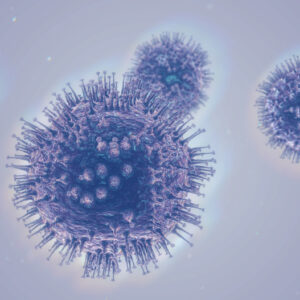Feline Coronavirus
Two forms of feline coronavirus (FCoV) are found in nature: enteric (FECV) and infectious peritonitis (FIPV). Feline enteric coronavirus is responsible for an infection of the mature gastrointestinal epithelial cells. This intestinal infection has few outward signs, and is usually chronic. The virus is excreted in the feces of the healthy carrier. The virus becomes feline infectious peritonitis virus (FIPV) when random errors occur in the virus infecting an enterocyte, causing it to mutate from FECV to FIPV. This facilitates infection of macrophages leading to the development of a fatal granulomatous vasculitis, or feline infectious peritonitis (FIP).
Feline Coronovirus Background
Feline coronavirus (FCoV) is a subspecies of the alphacoronavirus 1 species, along with canine coronavirus (CCoV). FCoVs appear to have emerged in the 1950s, possibly due to cross-species transmission, and cats worldwide have now been found to be infected with FCoV (Tasker, 2018). Two forms of feline coronavirus are found in nature: enteric (FECV) and FIP (FIPV). There are also two different serotypes found with different antigens that produce unique antibodies. FCoV serotype I (also called type I) is the most frequent. Type I, comprises FECV that could mutate to FIPV type I, and is responsible for 80% of the infections. FCoV serotype II (also called type II) is less frequent and is an FECV type II that can mutate to FIPV type II. FCoV type II is a recombinant type 1 virus with spike gene (S protein) replacement from FCoV by the canine enteric coronavirus (CCoV) spikes.
FCoVs are transmitted via the fecal-oral route and primarily infect enterocytes. Cats can become persistently infected and continuously or intermittently shed virus with the feces. There is strong evidence that only FECV and not FIPV is transmitted between cats. Infected cats generally remain healthy despite systemic infection, indicating that healthy (FECV) carriers play a key role in the epidemiology of FIP (Kipar & Meli, 2014). FECV is generally regarded as the avirulent pathotype of FCoV, and indeed, in older cats, oral FECV infection does not lead to any, or only very mild, nonspecific clinical signs, such as transient anorexia. However, in young kittens, FECV infection can induce severe enteritis (Kipar & Meli, 2014). Feline coronavirus (FCoV) infection is very common in cats, usually causing only mild intestinal signs such as diarrhoea. However, up to 10% of FCoV infections, result in the fatal disease feline infectious peritonitis (FIP) (Tasker, 2018). Feline infectious peritonitis (FIP) is one of the most important fatal infectious diseases of cats, the pathogenesis of which is not yet been fully understood (Kipar & Meli, 2014). FIP, together with panleukopenia and viral infections of the upper respiratory tract, is one of the leading infectious causes of death in cats, predominantly young (6 months to 2 years), purebred, male intact cats. Both FCoV serotypes can cause FIP, but serological and molecular studies have confirmed that type I FCoVs are dominant in the cat population worldwide, with the prevalence of seropositive animals reaching 98%.
Two theories have been proposed for FIP infection of the host; the “internal mutation” hypothesis and the “distinct circulating avirulent and virulent strains” hypothesis. The first model assumes that FIPVs arise in vivo from mutations of FECV in infected animals. Indeed, mutations in the S protein are likely to facilitate FCoV monocyte/ macrophage tropism and allow it to spread systemically, outside of the intestinal tract, contributing to the development of FIP. The second model proposes that FCoVs high viral mutation rate leads to the generation of viral quasispecies, comprising more virulent mutants (Tekes & Thiel, 2016). However, other factors play a role in the development of FIP. Disease progression also requires the virus to be able to replicate effectively and sustainably in monocytes of the infected host. In vitro, both FECV and FIPV can replicate in isolated feline peritoneal macrophages, BMDMs, and monocytes, but only FIPVs undergo sustainable replication and spread the infection in the culture. Host factors also play a role as cats also exhibit individual differences in the sustainability and susceptibility of monocytes to infection. Feline coronavirus infection in vivo generally leads to monocyte-associated viremia but viral replication in the blood (ie, in monocytes) and viral loads in tissues are generally significantly higher in association with FIP (Kipar & Meli, 2014).
Serology, based on the detection of feline coronavirus antibody titers by a range of methods (immunofluorescence, ELISA, rapid immunomigration), is widely used commercially to assist in the diagnosis of FIP and for quarantine purposes (Kipar & Meli, 2014). No curative treatments for FIP are currently available (Tasker, 2018).
References
- Kipar A, Meli ML. (2014). Feline infectious peritonitis: still an enigma?. Vet Pathol. 51(2):505–526.
- Tasker, S. (2018). Diagnosis of Feline Infectious Peritonitis: Update on Evidence Supporting Available Tests. J Feline Med Surg, 20 (3), 228-243.
- Tekes G, Thiel HJ. (2016). Feline Coronaviruses: Pathogenesis of Feline Infectious Peritonitis. Adv Virus Res. 96:193–218.
Feline Coronavirus Antigens
The Native Antigen Company is pleased to provide a native feline coronavirus antigen for all of your assay development and research needs.
Questions?
Check out our FAQ section for answers to the most frequently asked questions about our website and company.

